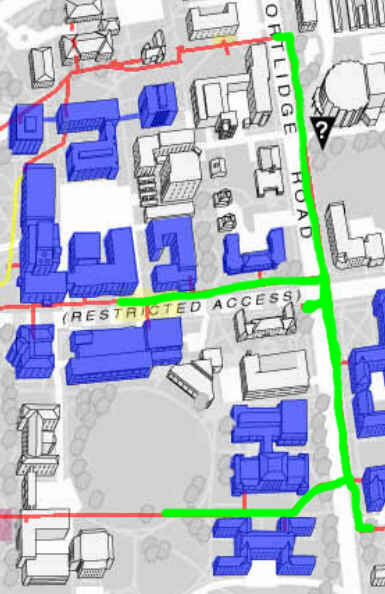
On Monday morning at approximately 3:00 AM, four of us entered the abandoned
steam tunnels underneath the Penn State University through a grating on the
street that we have acquired a key to. We ran down the concrete steps into the
hot, dry tunnel system that has been mapped for over 4 miles, plus many areas
that are not accessible, or that are yet to be traversed. Built in the early
1900s, and decommissioned during World War Two, they are now used to carry non-heating
related steam, air, and water pipes, not to mention a vast array of electrical
wiring.
I, along with another executive member, Glok, of the Gamepants.com infiltration
squad, and two peons.... er, I mean [CONFIDENTIAL] associates (Grencho and the
Amazing Shirtless Guy) were on this expedition. Armed with lights to guide our
path, and breath masks to shield us from the deadly espestos insulation that
still exists in some areas of the tunnels, we made our way towards the downtown
area of State College, only we were about four feet underneath it all.
The tunnels themselves are about five feet wide, by six and a half feet tall.
The steam pipes along the side narrow it down to only three feet of walking
space, and sometimes at a juncture or where the pipes switch sides, you have
to climb/crawl/duck to move past. As we entered, the steam pipes were along
the left side (heading southeast) and a bundle of electrical wires were jammed
into the left hand corner created where the wall and ceiling met. Every now
and then would be a small plaque labeling this section of the tunnels as section
"G". Grates were labeled according to their section and numbered ("G1", "G2"
, etc.).
We traveled about two hundred yards before we got to the famous Pollock underpass.
This underpass was a small tunnel that allowed pedestrians to cross the street
without having to stop traffic in the process. Unfortunately, it became a really
grungy drug hangout and the police and the campus shut it off only a few years
after it was built. One section of it (crossing Pollock, parallel to Shortlige
road) is only barred off with a chain and "No Trespassing" sign, whilst the
area crossing the other direction (crossing Shortlige, parallel to Pollock)
is closed off by a locked grating door. The tunnel system goes right through
this closed section of the underpass, and shows the paved over dead end where
the opening on the other side used to be.
At this junction, we officially had entered section "F" and continued to travel
in a southeasterly direction until we came to our first building entry. Although
we did not enter any of these such doors for fear of an alarm system, every
now and then would be a short branch off that lead to a locked door. All of
these doors are openable from the inside of the tunnel system, but require keys
to open them from inside the buildings. They all lead to basements, sub-basements,
or maintenance levels of the buildings along the tunnel system that are old
enough to be tied it. Newer buildings have buried pipes running out the side
of the tunnels leading to them, and no direct connection.
At the end of this tunnel, it branched off and we hung a left. After traveling
for a while we reached what appeared to be the basement level of a building.
A full size grate covered the entrance , but just a dead end into a room with
a bunch of pipes, regulators, and water heaters. We ran around for a while and
then headed back to the intersection. We went the other way and were a bit freaked
by the waves of heat coming out of this section of the tunnels, and eventually
reached a series of pipes that were blocking our path. We probably could have
gotten around them, but the map said that there was a section of tunnels up
ahead that was too hot to be traversed.
We turned around and headed back towards the way we came and found that we had
missed a turn off a little before the underpass because of the pipes switching
sides of the tunnels. We journeyed for a bit until turning back towards the
entrance. We took some pictures of our entrance point, and then ran back to
the underpass where we snuck out into the outer area and sent scouts up the
stairs to see when it was all clear for us to bolt out and run back to our vehicle.
Later expeditions into the steam tunnels have been carried out that have included
more building entries and also the traversing of the extreme heat zone (estimated
150 degrees). We plan to explore areas that have not been entered yet (ever,
by anyone other than authorized personal), and to assess the deadly espestos
problem.
